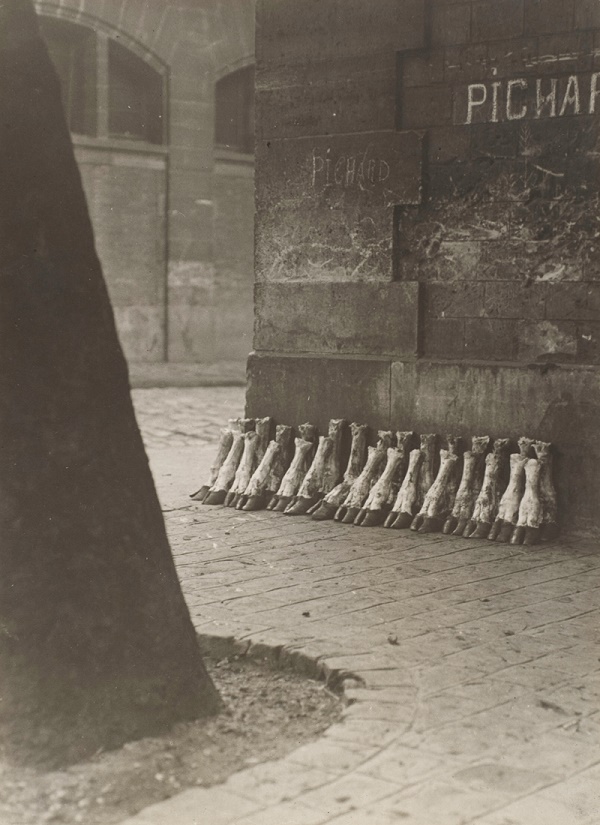
Eli Lotar, Aux Abattoirs de La Villette [At La Villette’s Slaughterhouses], 1929, coll. Metropolitan Museum, NYC

Eli Lotar, Aux Abattoirs de La Villette [At La Villette’s Slaughterhouses], 1929, coll. Metropolitan Museum, NYC
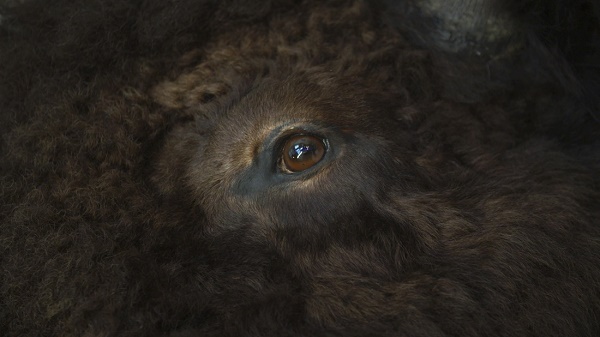
Ali Cherri, Somniculus, 2017
Museums, as objects, are here to tell us about an elsewhere that we don’t know, in order to educate us and provide us with rational, learned, Cartesian discourses —especially ethnographic, archeological and natural history museums. Of course, this is set in a model that structures our society and outlook. The same artifacts won’t relay the same discourse whether they are displayed in a “cabinet of curiosities,” a colonial museum, an antiques shop, a flea market or the Quai Branly museum. Our ideology in showing and exhibiting imposes itself on the artifact and our gaze has to conform to it. Sure, we can choose to be docile, because we are respectful, conformist, and learning; or we can choose to be skeptical and reluctant when faced with, for example, the national narrative of Napoleon III’s Second Empire, the racialist phrenology of colonial exhibitions, or falsified colonizing archeology in Moshe Dayan’s style. However, we always remain within this rational logic, consuming meaning and context.
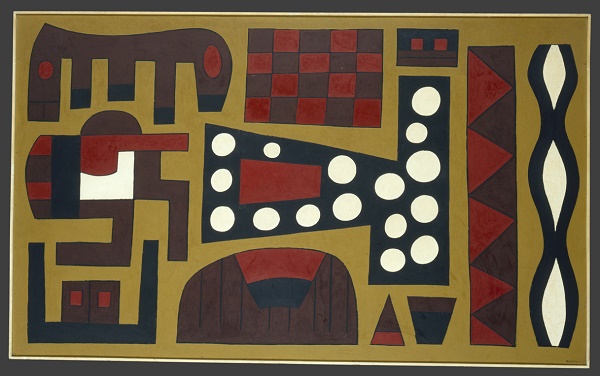
Joaquim Rodrigo, SA Estaçao, 1961
Lisbon’s Museo do Chiado has put forward an interesting initiative: under the title “Avant-garde and neo-avant-garde” (June 17, 2016 – June 17, 2017), it has elected to display the 20th– and 21st-century artworks of its collection, despite being almost exclusively known for its 19th-century pieces. However, at the risk of provoking my Portuguese friends’ outcries, I will say I was deeply bored visiting the rooms leading up to 1965. Not that I am not interested in movements like Futurism, Cubism, Surrealism or abstract art —far from it. But at the Chiado I saw mere adaptations, variations, imitations. I looked in vain for some unsettling, stimulating instances of creativity, only encountering earnest, well-rounded artworks that might have encapsulated what each of these movements were about, but that never really stood out on their own. (In the adjacent rooms, there is a dithyrambic exhibition on Amadeo de Souza-Cardoso, “greatest artist of the century,” a hidden gem finally revealed —like at the Grand Palais, I couldn’t appreciate it without taking into account the historical and cultural context.) Is this informed by Parisianocentric disdain for provincial follow-the-leader endeavors? Maybe, but then again I don’t have the same feeling of déjà-vu in front of Italian artists of this era, for instance.

First, astonishment seizes you: what? a Bernard Buffet exhibition (at the MAMVP, October 14, 2016 – March 5, 2017)? Then, doubt unfurls: maybe I’ve let something slip by me? Am I missing out on some revelation because of my prejudices?
After having seen the exhibition, it’s nothing but consternation: how could they dare to make such an unconvincing show? Or is it that rehabilitating Buffet amounted to an impossible task? And if so, why put together this exhibition? To please Pierre Bergé, the ex-boyfriend, who owns a fair amount of the paintings on display (his portrait pictured last)? I cannot think so. This is not a rediscovery or rehabilitation, this is a “rebranding” —on the walls of the exhibition, a quote from Bergé: “[Buffet’s] prickly signature has become a brand name.” Is this actually the context in which we should apprehend this promotional relaunch?

Cy Twombly, Night Watch, 1966, industrial paint, wax pencil on canvas, 190x200cm
I must admit from the get-go that I have never been a die-hard fan of Cy Twombly’s work; I do like his photographs and their faded hues, but his paintings often left me skeptical, or even worried. His retrospective at the Centre Pompidou (November 30, 2016 – April 24, 2017) had the merit to help me understand why. To me, Twombly oscillates between two poles: one is austere, abstraction-oriented, pared down, reduced to its simplest expression; the other is expressive, exuberant, almost baroque, and weighed down with references that can be seen as pretentious.

Philippe Cognée, Solar crowd, 2016, 150x150cm
Greyish, blueish, reddish canvases with muted hues: these are crowds, so we’re told. No border, no frame, what we see is only a fragment of an immensity that we assume stretches left and right, up and down, infinitely expanding, maybe, like photos of clouds. These are crowds of people, individuals lost in the mass, barely discernable. Each person moves, goes forward, makes a gesture; the whole thing is like an idiorhythmy, a community where everyone blends but no one disappears.

Carl Andre, poem, 1982
The Carl Andre exhibition at the MAMVP (October 18, 2016 – February 12, 2017) is a very good retrospective, ranging from his –large-scale or miniature– sculptures to his visual poems (lesser-known works, albeit their formal beauty is truly captivating, beyond meaningfulness). But something is arresting: the gap, probably an unbridgeable one, between the artist’s original intentions and the way his artworks are displayed in museums.
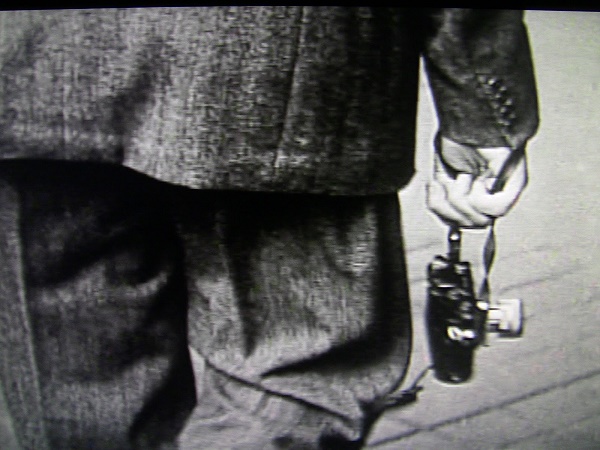
Granted, the exhibition “Images à la Sauvette” at the Fondation Cartier-Bresson (January 11 – April 23, 2017) is a great opportunity to see most of the photographs published in the eponymous –and mythical– album, be it for the first time or once again. Undoubtedly, it will be an interesting discovery for neophytes, and a refresh of pleasant memories for long-time amateurs of Henri Cartier-Bresson’s work. But it seemed there were no surprises, nothing original, until I happened on a short 1’40’’ film, shown in a nook, in which we can see the Frenchman at work (although he apparently hated being photographed of filmed), caught in action by the American photographer Gjon Mili. The scene takes place during the celebrations for the Chinese New Year in New York, in 1959: paper dragons, firecrackers, a crowd… nothing extraordinary, just partying. But in the midst of this crowd, we see a man dancing, jumping, bouncing around in whirls and zigzags, gently elbowing his way, taking a step back, two steps aside, three steps forward, ready for anything.

William Kentridge, “I am not me, the horse is not mine”, 2008
In Inhotim, I still had artworks to see, the more classical ones maybe or, in any case, those whose scenography felt less pompous. First, a superb polyptych by William Kentridge on eight screens, addressing the end of Constructivism, stifled by Stalin. Except for one screen devoted to text (the 1937 Central Committee’s deliberation expelling Bukharin from the party), Kentridge’s tried-and-true style is on display here. But what is featured? Nicolas Gogol’s nose – that other characters sometimes use as a mask –, a horse (“I am not me, the horse is not mine”), a Monument to the Third International that was never completed… And a dancing Red Army soldier, but only his shadow is visible – everything is an illusion. It would have been nice also to be able to watch the performance/speech [pdf] Kentridge gave to complement the installation.
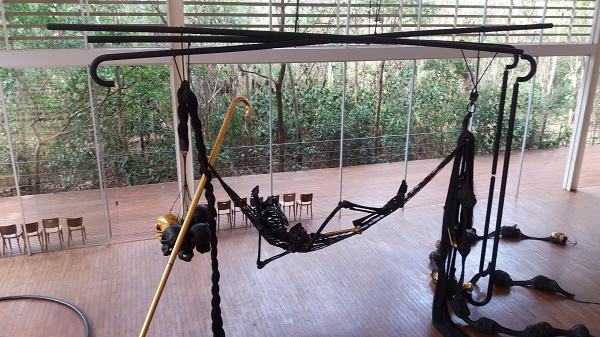
Tunga, view of the psychoactive pavilion
I don’t know if Tunga –who was apparently at the inception of Inhotim, having advised Bernardo Paz to create a museum– is “the best” artist here, and this kind of rankings are never very interesting: nevertheless, I felt that his two pavilions stand above the rest. The main one is a large structure, open on the forest, with a dozen oversized red hammocks connecting the building with the trees. In a central vault, one of Tunga’s films is on view; everything else is bathed by daylight, animated by a soft breeze, or entertained by a few raindrops. The superb installation that I saw at the Louvre eleven years ago is here, staging a confrontation of two worlds, accompanied by several works inspired by organic fluids (sometimes reminiscent of Chen Zhen’s artworks), such as Frascos expandidos from 2009 (featured below). Continue reading